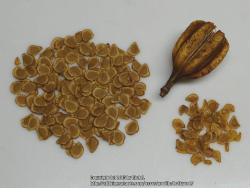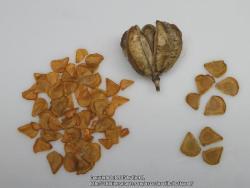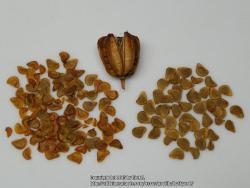I have finally finished candling my delayed hypogeal lily seed, so I ought to get to planting right away. I thought, though, that this would be a good way to illustrate the importance of parental compatibility.
Compatibility is a measure of how likely two parent plants (i.e. lilies) will produce viable seed. In general, the better the match of the pod and pollen parents, the more vigorous, more healthy and greater number of viable seed in a pod. Many environmental factors affect pollination, but here I only deal with genetics.
In nature, compatibility usually means the same species or variety within a species, or sometimes just closely related species. In cultivation, the question of compatibility is more complex, because we are able to coax along weak seedlings that would otherwise wither in the wild. We try all sorts of crossing combinations, even though they may be very unlikely to produce good seed. But maybe sometimes, we might get lucky and initiate viable seed that could turn into something extraordinary.
This is an example of good compatibility:
Lilium monadelphum x
Lilium monadelphum (mom and pop are not the same vegetative clone)
The pod is good sized, relative to the species’s norm, and normally shaped. It is filled with seed, and the ratio of viable seed (left) to chaff (non-viable seed on the right) is high.
 Incompatibility
Incompatibility means the two parents cannot produce viable offspring. You can’t cross a lion with a giraffe and get a girion or a liraffe. It just doesn't work. But, compatibility is not always so black and white. Parents can be partially compatible, to varying degrees. One can cross a horse with a donkey and get a mule, for instance, but the mule is almost always sterile. Still, a mule is very useful from this partially compatible cross, and so might a lily.
Two examples of partial compatibility:
Lilium ‘Mrs. R.O. Backhouse’ x (
Lilium martagon ‘Amelita’ x
Lilium ‘Super Tsing’)
Chaff on left, perhaps good seed upper right, likely not viable seed (but I will plant it anyway) lower right.
 Lilium martagon
Lilium martagon ’Amelita’ x
Lilium ‘Super Tsing’
Chaff on left, hopefully good seed on right. This may look like fairly good results, but often, when crossing genetically unlike parents (as these are), what seems like good seed doesn’t turn out to be. I had made this same cross years before, with similar results, but only 10 seeds grew. However, the pay back was fantastic!

Remember that off-color seed doesn’t necessarily mean anything bad. If the seed otherwise looks good, it probably is.
THis is blond seed from a complex martagon section cross. Can you see that most is good seed with just a little chaff?
 Edited for grammar
Edited for grammar



